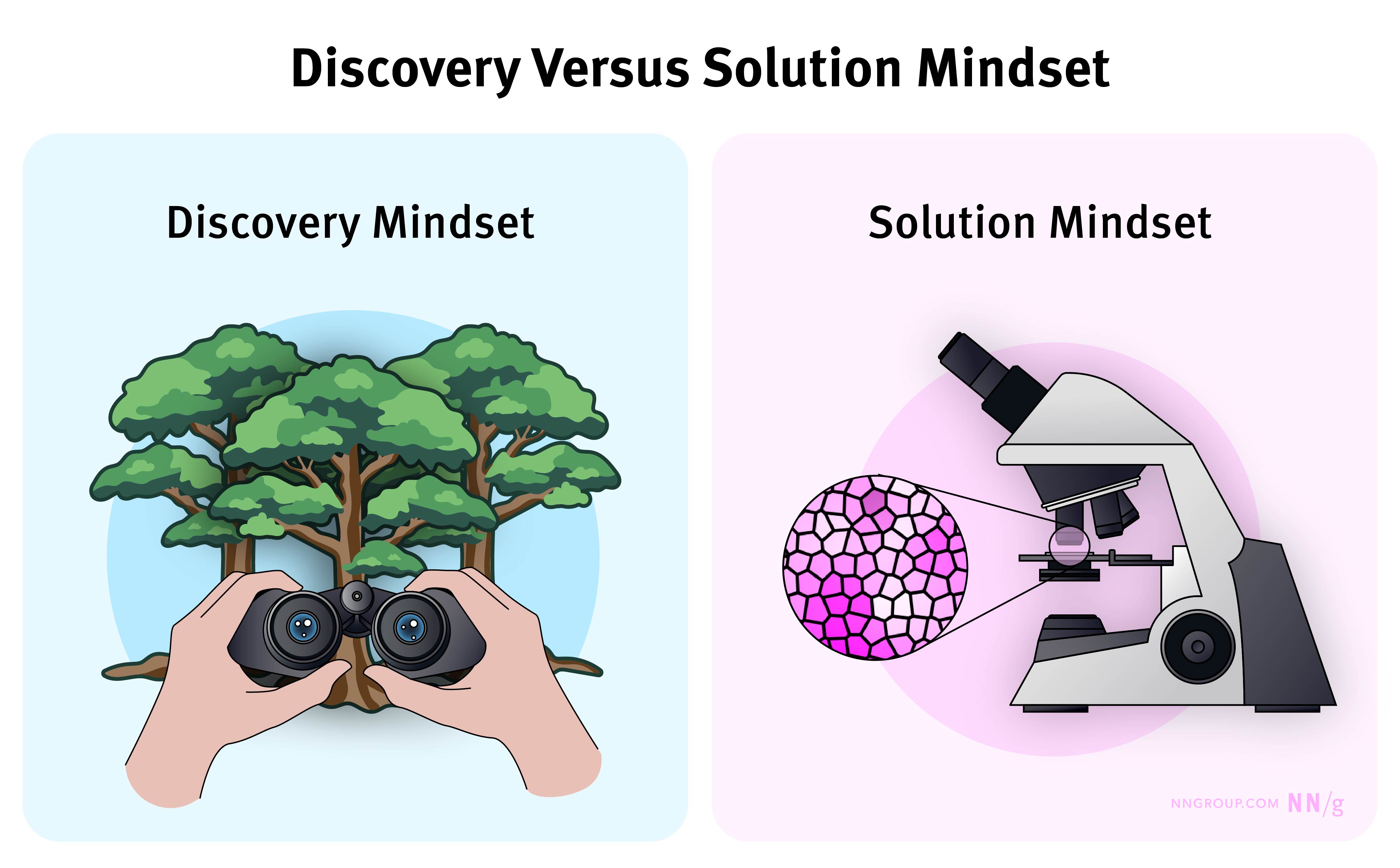Summary:
Successful discovery requires teams to be open to uncovering “unknown unknowns.” Center your discovery efforts around problems rather than solutions.
Discovery helps us decide what to build or what direction to pursue. To perform discovery well, we have to adopt a particular mindset: an exploration mindset and an openness to learn new things.
The Solution Mindset
Many discoveries start with exploring solutions. Consider these discovery goals:
- Identify how an AI chatbot can answer customers’ essential questions
- Identify what user needs exist for a new dashboard
- Explore how we can design a fulfillment tracker that helps users track their order
The problem with these goals is that they are too focused on specific solutions. When discoveries focus on solutions, teams can experience two common cognitive biases when conducting discovery research.
- Anchoring: Teams with a solution mindset often conduct discovery research through the lens of a particular solution. For example, they start by testing prototypes or interviewing target users about a solution rather than conducting exploratory research on the problem, such as how it comes about, who it affects, and how.
- Confirmation bias: When teams have a preferred solution in mind, they often seek evidence that their solution is the right one. They may ignore or avoid looking for evidence suggesting they’re wrong about the problem or the best solution.
Starting discovery with a solution in mind can limit your ability to discover valuable insights about your users and their needs and the problem you want to solve. You also risk building the wrong thing.
What a Discovery Mindset Means
A discovery mindset means that a team is open to learning
- That their assumptions are wrong, whether those assumptions are about users’ problems, needs, or the best solution.
- New things they hadn’t expected to learn (these are known as unknown unknowns). Unknown unknowns can sometimes change the trajectory of a discovery as a team gains new, important knowledge about the problem domain.
Adopting a discovery mindset helps teams gather valuable insights to identify the correct problems and solutions.
3 Methods to Avoid the Solution Mindset
Use these 3 tactics in your discovery efforts to encourage curiosity, avoid early conclusions, and embrace a data-driven approach.
1. Reframe the Goal
To avoid beginning discovery with the solution mindset, frame the goal of your discovery around a problem rather than a solution.
Everything we build solves a problem for your users; otherwise, it wouldn’t be used. If your team has a solution in mind, think about the underlying problem it solves.
Ask: What problem is this solution intended to solve?
| Solution | Example Problem it Solves |
|---|---|
| Dashboard | Help users make good decisions using up-to-date data |
| Chatbot | Provides reassurance and support when users have questions |
| Order tracker | Sets expectations for when an order will be fulfilled and provides peace of mind |
Once you’ve identified the problem, frame it as a goal for your discovery.
For example, the goals for these discoveries could be:
- Decide how we can provide users with the data they need to make good decisions
- Decide how best to provide reassurance and support for users with queries about their account
- Decide how we can provide transparency to users on the progress of their order
Starting with a broader goal that centers around a problem can help you identify important research questions that need to be answered.
For example, if the goal is to provide users with the data they need to make good decisions, we might need to research which decisions our users make, when they need up-to-date data and why, and how they use data in the decision-making process.
2. Highlight Unknowns and Assumptions
Another strategy to help us adopt a discovery mindset is to focus on what we know and don’t. When teams take time to do this at the beginning of discovery, they’re less likely to fall into the trap of trying to validate their assumptions.
Highlight facts and assumptions or unknowns with your team. This can be an exercise in a kick-off workshop.
Ask: What are we assuming about our users’ needs, behaviors, desires, or the problem context?
The team can also prioritize unknowns or assumptions. Some unknowns might be crucial to explore because you might take on a lot of risk if you don’t. Some unknowns might be nice to know but not essential to your project.
3. Icebox Favorite Ideas
To avoid teams anchoring on a particular solution, teams can ideate solutions at the start of discovery and agree to put their solution ideas “on ice” until the discovery research has been performed. This can be done in a kick-off workshop before creating discovery goals or research questions.
Ask: What solution ideas do we have now? Let’s document them for safekeeping and consideration later.
Iceboxing solution ideas has two advantages:
- Team members who are emotionally attached to specific solutions have their ideas heard and documented, freeing them from the worry that their ideas will get lost.
- Teams with one solution in mind can avoid narrow thinking by creating a space for other ideas to be considered.
After the team has done their discovery research and begun to ideate, they can consider the solutions in the icebox to see if any are a good fit.
Conclusion
Successful discoveries involve adopting the right mindset: open and solution-agnostic. To do so, frame your discovery goal around a problem rather than a solution, identify and icebox any solution ideas at the start, and spend time identifying assumptions and unknowns that need to be explored.
